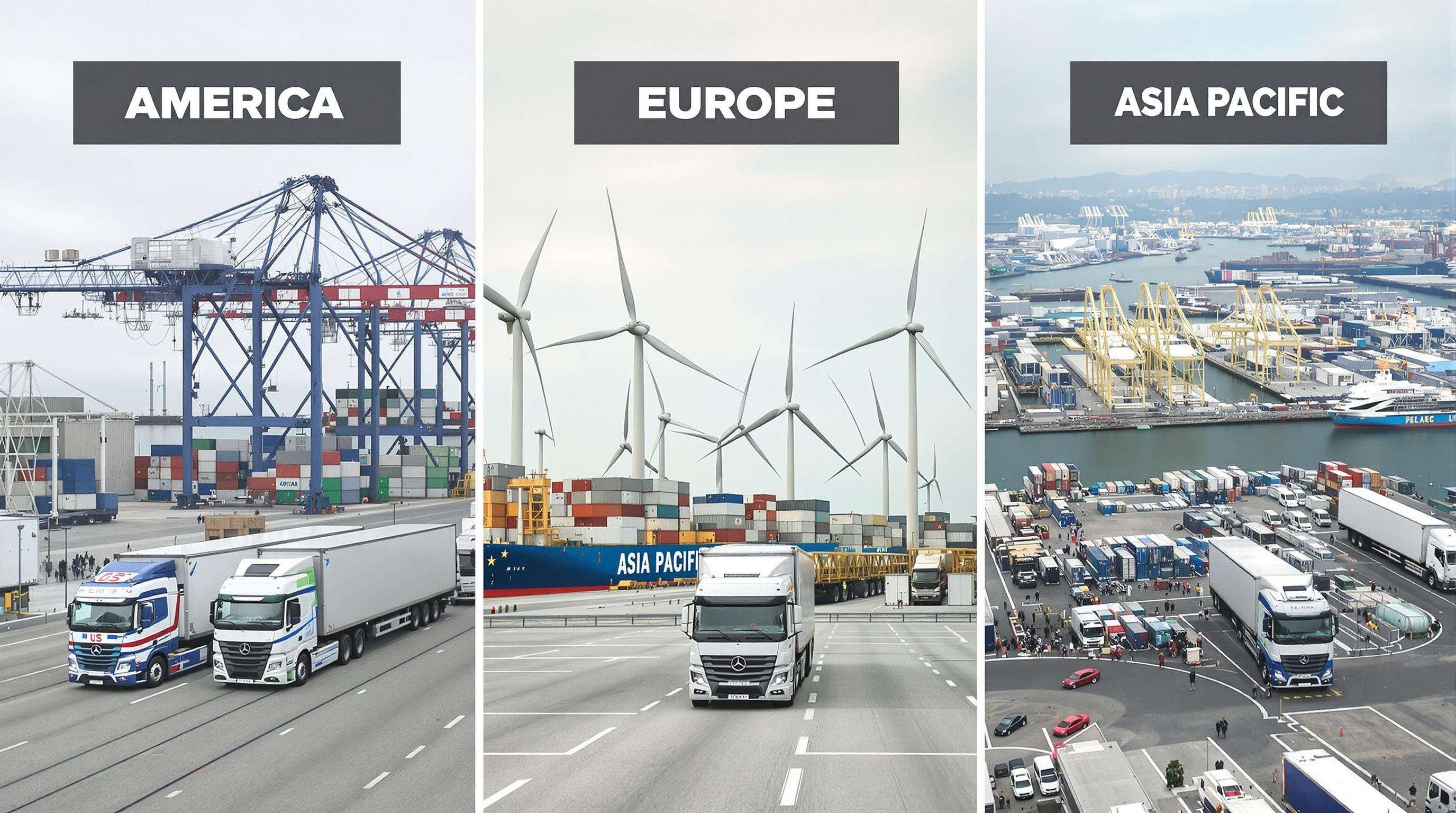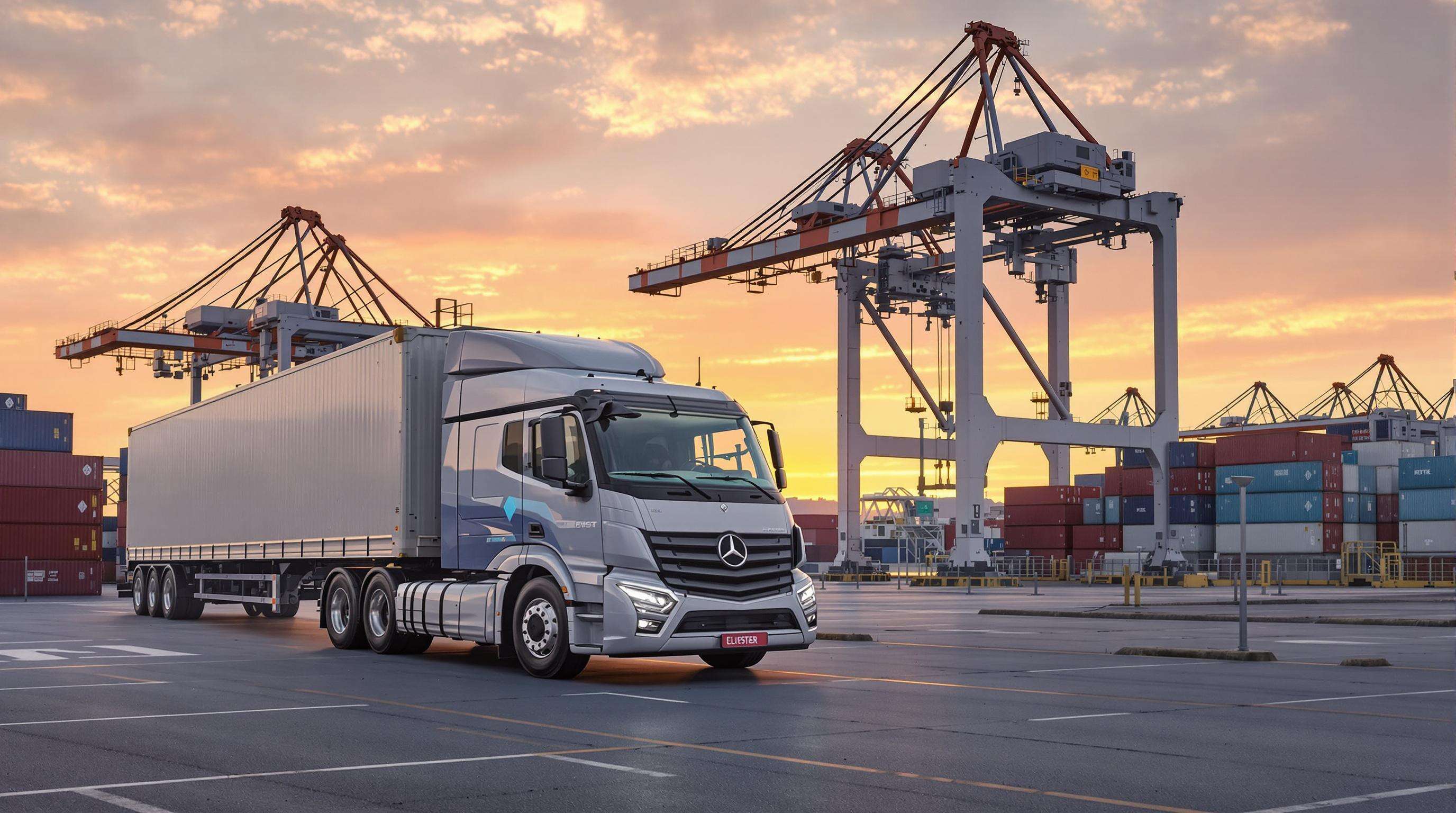24-D10, အဆောက်အအုံ 3, Aosheng Building, Shunhua Road Street, Jinan, Shandong, တရုတ် +86 13969167638 [email protected]
ကမ္ဘာလုံးဆိုင်ရာ စွမ်းဆောင်ရည် ဆိုင်ရာ လမ်းကြောင်းများ တိုးတက်လာမှုက အများအားဖြင့် ပိုမိုကြီးမားသော တရပ်တာ ကားများအတွက် လိုအပ်ချက်များကို တိုးမြှင့်လျက်ရှိသည်။ ၂၀၃၅ ခုနှစ်အထိ ကုန်ပစ္စည်း သယ်ယူပို့ဆောင်ရေး ပမာဏသည် ၂၇ ရာခိုင်နှုန်းခန့် တိုးတက်လာမည်ဟု လုပ်ငန်းအတွေ့အကြုံရှိသူများက ခန့်မှန်းထားပါသည်။ ကုမ္ပဏီများသည် မတိုင်ခင်က ဆက်သွယ်မှုနည်းပါးသော ဧရိယာများသို့ ကုန်ပစ္စည်းများ ပို့ဆောင်လာသည့်အခါတွင် ထိုသို့သော ရှုပ်ထွေးသော အကွာအဝေးများကို တွန်းလှန်နိုင်ပြီး ပိုမိုကြီးမားသော တာဝန်များကို သယ်ဆောင်နိုင်သည့် ပိုမိုကြီးမားသော ကားများကို လိုအပ်လာပါလိမ့်မည်။ ယနေ့ခေတ်တွင် ကုန်ပစ္စည်းများကို ပိုမိုရှုပ်ထွေးသော သယ်ယူပို့ဆောင်ရေးစင်တာများ သို့မဟုတ် နိုင်ငံ၏ ပိုမိုခွဲထွက်နေသော နေရာများသို့ ပို့ဆောင်ရန် ကြိုးပမ်းနေသည့် ကုန်စည်ပို့ဆောင်ရေး စီမံခန့်ခွဲမှု တာဝန်ရှိသူများသည် အများအားဖြင့် (တကယ်တော့ ထက်ဝက်ကျော်) ပိုမိုအားကောင်းပြီး ပိုမိုကောင်းမွန်သော ဆီစားနှုန်းရှိသည့် တရပ်တာများကို ပထမဆုံး စိတ်ဝင်စားကြသည်။ ကျွန်ုပ်တို့သည် ဖွံ့ဖြိုးဆဲနိုင်ငံများတွင် အဓိက အဆောက်အဦများ တည်ဆောက်နေမှုနှင့်အတူ ဤသို့ဖြစ်ပျက်လျက်ရှိပါသည်။ စက်မှုဇုန်များကို ကမ်းလှမ်းသည့်နေရာများနှင့် ကုန်ပစ္စည်းများကို တစ်မျိုးမျိုးမှ တစ်မျိုးသို့ လက်ပြောင်းရသည့် နေရာများသို့ တိုက်ရိုက်ချိတ်ဆက်ထားသော လမ်းမကြီးများသည် နေရာတိုင်းတွင် ပေါ်ထွက်လာနေပါသည်။
အွန်လိုင်းစျေးဝယ်ခြင်း၏ တိုးတက်မှုသည် အချိန်အကန့်အသတ်ရှိသော ပို့ဆောင်မှုများကို ကိုင်တွယ်ဖြေရှင်းသည့် အထူးယာဉ်များအတွက် လိုအပ်ချက်ကို တွန်းပိ့်ပေးခဲ့သည်။ နောက်ပိုင်း စက်မှုလုပ်ငန်းအစီရင်ခံစာများကိုကြည့်ပါက ၂၀၂၂ ခုနှစ်ဝန်းကျင်မှစ၍ နောက်ဆုံးမိုင်အကွာအဝေးအတွက် ပို့ဆောင်ရေးပစ္စည်းများဝယ်ယူမှုသည် ၄၂ ရာခိုင်နှုန်းခန့် တိုးတက်လာခဲ့သည်။ စားသုံးသူများသည် မှာယူသည့်နေ့တွင်ပင် ကုန်ပစ္စည်းများ ပို့ဆောင်ပေးရန်လိုအပ်နေသောကြောင့် စျေးဝယ်စင်တာများသည် လျော့နည်းစွာသာ လိုက်လျောညီထွေဖြစ်နေသည်။ ဤသည်မှာ ကုန်ပစ္စည်းများဖြင့် ပြည့်နှက်နေသော ကုန်းလမ်းယာဉ်များကို သယ်ဆောင်ရန်အတွက် အထူးပြုလုပ်ထားသော တရပ်တာတိုင်းလာများအတွက် ကောင်းမွန်သော သတင်းဖြစ်သည်။ ကုမ္ပဏီများသည် ကုန်ပစ္စည်းများကို ဂိုဒေါင်များမှ လူတို့၏လက်သို့ ယခင်ကထက် ပိုမိုမြန်ဆန်စွာ ရရှိစေရန် ကြိုးပမ်းနေကြသည်။ ထို့အပြင် ကြီးမားသော ကုန်စည်သယ်ယူပို့ဆောင်ရေးကုမ္ပဏီများသည် ယခင်က ပိုက်ဆံများစွာ ကုန်းယာဉ်များကို တိုးတက်စေရန် အသုံးပြုခဲ့သည်နှင့် နှိုင်းယှဉ်ပါက ၃၄ ရာခိုင်နှုန်းခန့် ပိုမိုသုံးစွဲနေကြသည်။ အဘယ်ကြောင့်ဆိုသော် ယနေ့ခေတ်တွင် လူတို့သည် ၎င်းတို့၏ပို့စ်ကတ်များကို ယခင်ကထက် ပိုမိုမြန်ဆန်စွာ ရရှိလိုလျက်ရှိသောကြောင့်ဖြစ်သည်။
ကမ္ဘာတစ်ဝှမ်းရှိဆိပ်ကမ်းများတွင် ကုန်ပိုးစီးရီးခုနှစ်အရေအတွက်သည် အနှစ်တွင် ၈၅၀ သန်းခန့်အထိရှိခဲ့ပါသည်။ အဆိုပါစီးရီးခုနှစ်အရေအတွက်များကြောင့် အလေးချိန်များကိုက်တွယ်သော တာမီနယ်တရပ်တာများအတွက် လိုအပ်ချက်မှာ တိုးတက်လျက်ရှိပါသည်။ စာရင်းများအရ အဆိုပါစက်များသည် ရှန်ဟိုင်းနှင့်လော့စ်အိန်ဂျလိစ်ကဲ့သို့သော ကမ္ဘာ့အရေးပါသည့် သင်္ဘောဆိပ်များတွင် ဝယ်ယူလျက်ရှိသော စက်များ၏ ၂၈ ရာခိုင်နှုန်းခန့်ကိုယူပိုင်းပါသည်။ အကြောင်းအရင်းမှာ သင်္ဘောများမှ ကုန်ပိုးများကိုသိုလှောင်ရာနေရာများသို့ရွှေ့ပြောင်းရာတွင် ကုန်ကျစရိတ်ကိုလျော့နည်းစေရန် လူတိုင်း၏ဆန္ဒရှိနေကြပါသည်။ နောက်ပိုင်းစီးပွားရေးအချက်အလက်များအရ အသက်အားဖြင့်ပိုမိုနုပျိုသော တရပ်တာများသည် ဟောင်းနွမ်းသောမော်ဒယ်များနှင့်နှိုင်းယှဉ်ပါက တစ်နေ့လျှင်ကုန်ပိုးစီးရီးခုနှစ် ၄၀ ရာခိုင်နှုန်းခန့်ကို စီမံနိုင်ပါသည်။ အဆိုပါစွမ်းရည်မှာ တစ်နာရီလျှင်ကုန်ပိုးစီးရီးခုနှစ်ထောင်ချီ၍ ဖြတ်သန်းနေသောနေရာများတွင် အထူးအရေးပါပါသည်။ ထို့ကြောင့် အချိန်အခါများတွင် ကုန်ပိုးများကျပ်တည်းနေသောအခါတွင်ပင် လည်ပတ်မှုများကို နူးညံ့စွာဆောင်ရွက်နိုင်စေရန်ကူညီပေးပါသည်။

ကားပို့ဆောင်ရေးကားများအား တိုးတက်စေရန် အမေရိကနှင့် ကနေဒါတို့သည် အမှန်တကယ်အားဖြင့် တိုးတက်လာနေပါသည်။ ထုတ်လုပ်သူများသည် ၂၀၂၂ ခုနှစ်ကတည်းက ထိုကောင်းမွန်သော တရပ်တာကားများအတွက် မှာယူမှုများသည် ၂၃% ခန့်တိုးပွားလာခဲ့ပါသည်။ ယနေ့ခေတ်တွင် ဆိပ်ကမ်းများတွင်ဖြစ်ပျက်နေသည့်အရာများကိုကြည့်ပါက အလိုအလျောက်နားလည်နိုင်မည့်အရာဖြစ်ပါသည်။ ဥပမာအားဖြင့် လော့စ်အိန်ဂျလိစ်မှ ၄၀ ကီလိုမီတာခန့်ကို မကြာသေးမီက တစ်နှစ်တာအတွင်း ၉.၃ သန်းခန့်သော TEUs များအား ဆိပ်ကမ်းများမှတဆင့် ရွှေ့ပြောင်းခဲ့ပါသည်။ ထိုကဲ့သို့သော ပမာဏများကိုကြည့်ပါက ကုမ္ပဏီများအနေဖြင့် စီးပွားရေးလုပ်ငန်းများအား တိုက်ရိုက်ဆက်သွယ်ပေးနိုင်ရန်အတွက် တာမီနယ်တရပ်တာကားများကို လိုအပ်နေပါသည်။ ဒေသတစ်ခွင်တွင် တစ်နှစ်လျှင် ၂.၁ ထရီလီယံဒေါ်လာခန့်တန်ဖိုးရှိသော ကုန်ပစ္စည်းများအား သယ်ယူပို့ဆောင်ပေးနေပါသည်။ ၂၀၂၃ ခုနှစ်တွင် DOT မှထုတ်ပြန်သောအချက်အလက်များအရ အမေရိကန်တွင် ကုန်ပစ္စည်းများ၏ ၃၄% ခန့်သည် နိုင်ငံတကာနယ်မြေများသို့ ဖြတ်ကျော်သွားလာနေပါသည်။ ထိုကဲ့သို့သော လှုပ်ရှားမှုများကြောင့် ကောင်းမွန်သော စီမံခန့်ခွဲမှုစနစ်များနှင့် ကုန်ပစ္စည်းများကို သယ်ယူပို့ဆောင်ရေးအတွက် လျှပ်စစ်ဓာတ်ကားများအား တိုးတက်စေရန် လိုအပ်နေပါသည်။
ဥရောပသမဂ္ဂရှိ ဖစ်ဖော် ၅၅ အစီအစဉ်ကဲ့သို့ မူဝါဒများသည် ဥရောပတိုက်တွင် လျှပ်စစ် တာမီနယ် တရပ်ကားများသို့ ပြောင်းလဲရန် အမှန်တကယ် တွန်းအားပေးနေပါသည်။ ဥပမာအားဖြင့် နော်ဝေတွင် ၂၀၂၅ ခုနှစ်အထိ ဆိပ်ကမ်းယာဉ်များအားလုံးကို သုည အမှုန့်အမှှုန်များဖြင့် မောင်းနှင်ရန် ပစ်မှတ်ထားပါသည်။ ဂျာမနီတွင် ဒီဇယ်မီးမရှိသော ဆိပ်ကမ်း ၂၀၃၀ စီမံကိန်းသည် ၂၀၂၁ ခုနှစ်မှစ၍ တာမီနယ်များတွင် CO2 ထုတ်လွှတ်မှုကို ၄၀% ခန့် လျော့နည်းစေပါသည်။ ပြင်သစ်တွင် အလေးချိန်ပိုမိုရှိသော ယာဉ်များအတွက် အထောက်အပံ့များ ထုတ်ပြန်ခဲ့ပြီး ဟိုက်ဘရစ် တရပ်ကားများတပ်ဆင်မှုကို ၃၀% ခန့် တိုးတက်စေပါသည်။ ယခုအခါ ကာဗွန်စျေးနှုန်းများသည် တန်လျှင် ၈၅ ဥရောပငွေကို ကျော်လွန်နေပြီဖြစ်သောကြောင့် ထုတ်လုပ်သူများသည် သုတေသနအတွက် ငွေပမာဏ၏ တစ်ဝက်ခန့်ကို ဘက်ထရီဖြင့် မောင်းနှင်သော ပရိုတိုထိပ်များကို တိုးတက်စေရန် ထောက်ပံ့ပေးနေပါသည်။ နောင်တွင် ဥရောပတွင် ရေကြောင်းသယ်ယူပို့ဆောင်ရေး အသင်းက နောက်တစ်ဆယ်စု၏ အလယ်ခေါင်းလောက်တွင် အနောက်ဥရောပတိုက်တွင် ရောင်းချမည့် တာမီနယ် တရပ်ကားအသစ်များ၏ ၆၀% မှာ လျှပ်စစ်မော်ဒယ်များဖြစ်လိမ့်မည်ဟု ခန့်မှန်းထားပါသည်။
တရုတ်အစိုးရ၏ ၁၅၆ ဘီလီယံဒေါ်လာခန့် ကမ်းလှမ်းငွေဖြင့် ဆိပ်ကမ်းများ တိုးတက်စေရန် စီမံကိန်းက စက်ရုပ်ဆိပ်ကမ်းတရပ်တာများအတွက် အားတိုးမှုကြီးကို ဖြစ်စေခဲ့ပြီး ၂၀၂၁ ခုနှစ်ကတည်းက အမှာစာများကို နှစ်ဆတိုးလာခဲ့သည်။ ဤသို့ဖြစ်ပေါ်လျက်ရှိသည့် တိုင်းပြည်တွင်းရှိ ဆိပ်ကမ်းကြီး ၁၂ ခုကို ကြည့်ပါ။ ရှန်ဟိုင်းက ပြီးခဲ့သည့်နှစ်က ဆိပ်ကမ်းယာဉ်အသစ် ၄၂၀ ကိုသာလျော်တင်သွင်းခဲ့သည်။ ဤတိုးတက်မှုများက ကုန်ပစ္စည်းများကို ယခင်ကထက် ပိုမိုမြန်ဆန်စွာ ကိုင်တွယ်နိုင်ရန် လမ်းစခံပေးနေခြင်းဖြစ်သည်။ အိန္ဒိယတွင်လည်း Sagarmala စီမံကိန်းက စျေးကွက်တွင် အသံတိုးလာနေသည်။ ကျွန်ုပ်တို့သည် ဆိပ်ကမ်းပစ္စည်းကိရိယာများဝယ်ယူမှု တစ်နှစ်တာအတွင်း ၃၁ ရာခိုင်နှုန်း ကြီးထွားမှုကို တွေ့မြင်နေရသည်။ အိန္ဒိယတွင်သာမက အရှေ့တောင်အာရှနိုင်ငံများတွင်လည်း ဤလှုပ်ရှားမှုများကို ပါဝင်လုပ်ဆောင်နေကြသည်။ ဥပမာအားဖြင့် ဗီယက်နမ်က စက်မှုဇုန်အသစ်များ တည်ဆောက်ခြင်းနှင့် အပြန်အလှန်ကုန်ပစ္စည်းသယ်ယူပို့ဆောင်ရေးကွန်ရက်များ တိုးချဲ့လာခြင်းကြောင့် ကုန်သွားယာဉ်များ တင်သွင်းမှုတွင် နှစ်စဉ် ၁၈ ရာခိုင်နှုန်းခန့် ကြီးထွားမှုကို တွေ့ရသည်။
ဒေသတွင်း အနံ့အသက်စံနှုန်းများကြောင့် ကွဲပြားသော အသုံးပြုမှုအချိန်ဇယားများကို ဖန်တီးခဲ့သည်။ ကယ်လီဖိုးနီးယား၏ တိုးတက်သော သန့်ရှင်းသော ကားများဆိုင်ရာစည်းမျဉ်းမှာ ၂၀၃၅ ခုနှစ်အထိ လျှပ်စစ်ကားများရောင်းချမှု၏ ၅၅% ကို တောင်းဆိုထားပြီး အိန္ဒိယ၏ BS VI စံနှုန်းများမှာ ဒီဇယ်ဖြင့် လည်ပတ်သော ကားများကို ပြုပြင်မွမ်းမံရန် နေရာပေးသည်။ ဤကွဲပြားသော စည်းမျဉ်းများကြောင့် ထုတ်လုပ်သူများသည် တစ်ချိန်တည်းတွင် ၃-၅ ခုအထိ မတူညီသော ပါဝါတရမ်များကို ထိန်းသိမ်းထားရန် လိုအပ်သည်။
| ဒေသ | အဓိက စည်းကမ်းချက် | အသုံးပြုနှုန်း တိုးတက်မှု (၂၀၂၃) |
|---|---|---|
| မြောက်အမေရိက | EPA Tier 4 Final စံနှုန်းများ | ၂၂% |
| ဥရောပ | Euro VII အနံ့အသက်စံနှုန်းများ | ၃၈% |
| အာရှ-ပစိဖိတ် | တရုတ် VI အနံ့အသက်စံနှုန်းများ | 17% |
ဥရောပသည် လျှပ်စစ် တာမီနယ် တရပ်တာများကို အသုံးပြုမှုတွင် ၅၄% အစုရှယ်ယာဖြင့် ဦးဆောင်နေပြီး မြောက်အမေရိကတွင် ၂၉% နှင့် အာရှပစိဖိတ်တွင် ၁၂% ရှိသည်။

အခုလက်ရှိ စွမ်းအင်အားဖြင့် မောင်းနှင်သော တာမီနယ် တြပ်ကားများသည် ကမ္ဘာ့ကုန်ပို့ကုန်ဆောင် စီးပွားရေးတွင် အကြီးအကျယ် အသုံးပြုလျက်ရှိပြီး ယခင်နှစ်က မော်ဒယ်များနှင့် နှိုင်းယှဉ်ပါက အသုံးပြုမှု ၄၂% ခန့် တိုးတက်လျက်ရှိသည်။ အဘယ်ကြောင့်နည်းဟု မေးပါက ပိုမိုတင်းကျပ်သော မီးခိုးထုတ်လွှတ်မှု စည်းမျဉ်းများနှင့် ပိုမိုကောင်းမွန်သော ဘက်ထရီများ တိုးတက်လာမှုကြောင့် ဤစွမ်းအင်အားဖြင့် မောင်းနှင်သော တြပ်ကားများသည် ဆိပ်ကမ်းများအတွက် ပိုမိုဆွဲဆောင်မှုရှိလာသည်။ ဆိပ်ကမ်းမန်နေဂျာများသည် လေထုအရည်အသွေးဆိုင်ရာ ရည်မှန်းချက်များကို ပြည့်မီအောင် ဆောင်ရွက်နိုင်ရန် အများအားဖြင့် သုည မီးခိုးထုတ်လွှတ်သော ယားယာဥ်များကိုသာ အသုံးပြုလျက်ရှိသည်။ ထို့အပြင် လောင်စာအဖြစ် လီသီယမ် ဘက်ထရီများကို အသုံးပြုသော ယာဥ်များသည် ပြန်လည်အားသွင်းရန် လိုအပ်မှုမရှိဘဲ ၈ နာရီမှ ၁၀ နာရီအထိ ဆက်တိုက် အလုပ်လုပ်နိုင်သည်။ စွမ်းအင်အားဖြင့် မောင်းနှင်သော ယာဥးများသို့ ပြောင်းလဲသုံးစွဲမှုသည် အပ်စ်ကောင်းသော သတင်းတစ်ခုဖြစ်သည်။ အပူချိန် ၂၀၂၅ တွင် ကာဗွန်ဓာတ်ပါဝင်မှုကို လျော့နည်းစေရန် တိုက်တွန်းနေသော အပြည်ပြည်ဆိုင်ရာ သမုဒ္ဒရာရေကြောင်း အဖွဲ့အစည်း၏ ရည်မှန်းချက်များနှင့် ဤလုပ်ငန်းစဉ်သည် ကိုက်ညီနေသည်။ တိုက်ရိုက်မဆိုင်ကြောင်း သိရှိသော်လည်း ဆိပ်ကမ်းများတွင် သဘာဝလောင်စာများကို အသုံးပြုခြင်းမှ ရပ်စဲပြီး သန့်ရှင်းသော စွမ်းအင်များသို့ ပြောင်းလဲသုံးစွဲမှုကို အမှန်အကန် တိုးမြှင့်ပေးနေသည်။
ယခုအချိန်တွင် စိတ်ကြိုက်အလိုအားလုံးကိုထိန်းချုပ်သော တော်ဝှေးများကို ကိုင်တွယ်ရာတွင် အလိုအလျောက်စနစ် တီထွင်မှုသည် ကြီးမားသော လော်ဂျစ်စတစ်စင်တာများတွင် လှိုင်းလုံးကြီးကိုဖြစ်စေသည်။ လမ်းကြောင်းစီမံခန့်ခွဲမှုအတွက် AI၊ ယာဉ်များနှင့် အခြေခံအဆောက်အအုံများကြား 5G ချိတ်ဆက်မှုများ၊ စက်များကို မျှတစွာမလည်ပတ်နိုင်မီ မျှတစွာလည်ပတ်နေသော ကြိုတင်ပြုပြင်ထိန်းသိမ်းမှုစနစ်များကြောင့် ကျွန်ုပ်တို့သည် ကိုင်တွယ်မှုအချိန်များတွင် ၁၈ မှ ၂၂ ရာခိုင်နှုန်းခန့် လျော့နည်းသွားခြင်းကိုတွေ့ရပါသည်။ ပြီးခဲ့သည့်နှစ်က Port Technology Journal မှ ဖော်ပြချက်အရ ဤစနစ်များကြောင့် အလုပ်ရပ်ခြင်းသည် ရာခိုင်နှုန်း ၄၀ ခန့် လျော့နည်းသွားပါသည်။ ဤအရာများက တစ်ပြိုင်နက်တည်းတွင် အခြေခံလည်ပတ်မှုများအတွက် ဆိပ်ကမ်းများသည် နေရာကြီးများ သို့မဟုတ် ပစ္စည်းကိရိယာများ ထပ်မံမလိုအပ်ဘဲ နေ့စဉ်တွင် တော်ဝှေးများကို ၂၈ ရာခိုင်နှုန်းခန့် ပိုမိုကိုင်တွယ်နိုင်ပါသည်။ ကမ္ဘာ့ကုန်သွယ်မှုများ တိုးတက်လာနေသည့်အချိန်တွင် စွမ်းရည်များတိုးတက်လာမှုသည် အမြီးကြီးငွေကြေးရင်းနှီးမြှုပ်နှံမှုမလိုဘဲ ထိရောက်သောလည်ပတ်မှုကို ထိန်းသိမ်းရာတွင် ဂိမ်းပြောင်းလဲမှုတစ်ခုဖြစ်ပါသည်။
ဥရောပရှိ Euro VII စည်းမျဉ်းများနှင့် ကယ်လီဖိုးနီးယား၏ တိုးတက်သော သန့်ရှင်းသောကားများအတွက်လိုအပ်ချက်များကဲ့သို့ စည်းမျဉ်းများသည် ကုမ္ပဏီများအား သူတို့၏ယာဉ်စီကိုတိုးတက်စေရန်တွန်းအားပေးနေပါသည်။ ယနေ့ခေတ်တွင် စက်မှုဇုန်များသို့ဝယ်ယူသော စက်မှုယာဉ်များ၏ သဘောတူညီချက်များ၏ နှစ်ပိုင်းတွင် တစ်ပိုင်းသည် အများအားဖြင့် အထွက်ဓာတ်လျော့နည်းသော သဘောတူညီချက်များပါဝင်ပါသည်။ စီးပွားရေးယာဉ်များက စီးပွားရေးအတွက် အကျိုးအမြတ်ပြန်ရရှိသည့်အချိန်မှာ ပျမ်းမျှအားဖြင့် လ ၁၄ လခန့်သာကြာပြီး ဆီစွ расходများလျော့နည်းမှုနှင့် အခွန်လျော့နည်းမှုများကြောင့်ဖြစ်ပါသည်။ အချို့ဒေသများတွင် အီလက်ထရစ်ဓာတ်မီတာများ မပေါ်ထွက်နေသေးသောဒေသများတွင် ဟိုက်ဘရစ်ကားများသည် အဆင်ပြေသောအလယ်အလတ်ဖြေရှင်းချက်အဖြစ်သုံးသပြီး အဆင်ပြေသောအချိန်ကို စောင့်နေသည်။
| ဒေသ | အကျိုးကျေးဇူးအမျိုးအစား | လက်ခံမှုနှုန်းသက်ရောက်မှု |
|---|---|---|
| မြောက်အမေရိက | ၃၀% အခွန်ပြန်ပေးခြင်း | +၄၉% နှစ်စဉ်တိုးတက်မှု |
| ယူအော် | အမှိုက်ထုတ်လဲလှယ်ခွင့်များ | +၆၃% ၂၀၂၂ ခုနှစ်ကတည်းက |
| အာရှ-ပစိဖိတ် | ဓာတ်မီတာတပ်ဆင်ရေးအတွက်အကူအညီများ | +၈၁% အဓိကစင်တာများတွင် |
တရုတ်နိုင်ငံ၏ $2.8 ဘီလီယံ NEV အထောက်အပံ့အစီအစဉ်သည် ဆိပ်ကမ်းယာဉ်ပို့ဆောင်ရေးတွင် ဒေသဆိုင်းရာ EV အသုံးပြုမှု၏ ၇၄ ရာခိုင်နှုန်းအတွက် တာဝန်ရှိပြီး ပုံမှန်နှင့် လျှပ်စစ်တွန်းလှန်းရောက်ယာဉ်များအကြား ကုန်ကျစရိတ်ကွာဟချက်ကို ဖြည့်ဆည်းပေးနေသည်။
စျေးကွက် သုတေသနအရ ကမ္ဘာ့ တာမီနယ် တရပ်တာ စက်မှုလုပ်ငန်းသည် ၂၀၂၅ ခုနှစ်တွင် ဒေါ်လာ ၁.၅၅ ဘီလီယံမှ ၂၀၃၂ ခုနှစ်အထိ ဒေါ်လာ ၂.၂၅ ဘီလီယံအထိ ခြောက်ရာခိုင်နှုန်းခန့် ကြီးထွားလာမည်ဖြစ်ပြီး ၂၀၂၅ ခုနှစ်တွင် Research and Markets မှ ထုတ်ပြန်ခဲ့သည့် အချက်အလက်များအရ နှစ်စဉ် ပျမ်းမျှ ကြီးထွားမှုနှုန်းသည် ၅.၅ ရာခိုင်နှုန်းခန့် ရှိမည်ဖြစ်သည်။ ဤကြီးထွားမှုနှုန်းကို မည်သည့်အရာက မောင်းနှင်နေသနည်း။ ကုန်ပစ္စည်း သင်္ဘောတင်ပို့မှု ပမာဏသည် နိုင်ငံတကာ ကုန်သွယ်မှု တိုးတက်မှုကြောင့် တိုးတက်လျက်ရှိပြီး ၂၀၂၃ ခုနှစ်ကတည်းက နှစ်စဉ် ၁၈ ရာခိုင်နှုန်းခန့် တိုးပြီး တိုးတက်လျက်ရှိသည်။ ကမ္ဘာတစ်ဝှမ်းရှိ လော့ဂစ်စတစ်စင်တာများသည် ကုန်ပစ္စည်းများကို ပိုမိုတင်ပို့နိုင်ရန် သူတို့၏ တရပ်တာများကို တိုးတက်အောင် ရင်းနှီးမြှုပ်နှံနေကြသည်။ အထူးသဖြင့် ကုမ္ပဏီများက စျေးနှုန်းနှင့် လုပ်ဆောင်နိုင်မှုအလေးချိန်ကို ကောင်းစွာထိန်းသိမ်းထားနိုင်သောကြောင့် ၄x၂ တန်ဖိုး ပုံစံများသည် စျေးကွက်တွင် နှစ်ပုံတစ်ပုံခန့်ကို ဖုံးလွှမ်းလျက်ရှိသည်။
| အပိုင်း | ၂၀၂၅ စျေးကွက်တန်ဖိုး | ၂၀၃၂ ခန့်မှန်းခြေအားဖြင့် | CAGR |
|---|---|---|---|
| လျှပ်စစ်ပုံစံများ | ဒေါ်လာ ၄၁၀ သန်း | ဒေါ်လာ ၁.၁ ဘီလီယံ | ၁၂.၇ ရာခိုင်နှုန်း |
| အော်တိုမေးတစ် နည်းပညာ | ဒေါ်လာ ၂၉၀ သန်း | ဒေါ်လာ ၈၇၀ သန်း | ၁၅.၄% |
စင်ကာပူ၊ ရောတာဒမ်နှင့်လောစိန်းကဲ့သို့သော ကမ္ဘာ့ပို့ဆောင်ရေးဆိပ်ကမ်းကြီးများတွင် ခေတြားအဆင့်မြှင့်တင်ရေးဆောင်ရွက်မှုများက ၂၀၃၀ နှိုင်းယှဉ်ပါက တာမီနယ်ထရပ်ကားများအတွက် စွမ်းရည်မှာ ၄၂ ရာခိုင်နှုန်းခန့်ရှိလိမ့်မည်ဟု မျှော်လင့်ထားပါသည်။ အီးကော်မာစ်ဖြည့်စွက်ရောင်းချသည့်စင်တာများအတွက် ထရပ်ကားများဝယ်ယူမှုမှာ တိုးတက်လျက်ရှိပါသည်။ ကုမ္ပဏီများက ကုန်ပစ္စည်းတင်တဲများကို စတိုဗိုင်းတွင်းသို့ ပိုမိုမြန်ဆန်စွာရွှေ့ပြောင်းလိုသောကြောင့် ယခုအချိန်တွင် စျေးကွက်ရှယ်ယူမှု၏ ၂၈ ရာခိုင်နှုန်းအထိရှိလာပြီး ၂၀၂၁ ခုနှစ်က ၁၉ ရာခိုင်နှုန်းရှိခဲ့သည်။ ၂၀၂၅ ခုနှစ်က စျေးကွက်ခန့်မှန်းချက်အရ ကုန်ပစ္စည်းများကိုင်တွယ်ဖြေရှင်းမှုမြန်ဆန်မှုသည် ကမ္ဘာ့လော့ဂ်စ်တစ်အခြေခံအဆောက်အဦများဖွံ့ဖြိုးတိုးတက်မှုကို ပုံသွင်းနေသော အဓိကအကြောင်းအရင်းများထဲမှတစ်ခုဖြစ်လာနေပါသည်။
ယနေ့ခေတ်ထုတ်လုပ်သူများသည် ၎င်းတို့၏ သုတေသနငွေ၏ ၂၂ မှ ၃၅ ရာခိုင်နှုန်းအထိ EV များနှင့် ကိုယ်ပိုင်မောင်းနှင်ရေးနည်းပညာများတွင် ရင်းနှီးမြှုပ်နှံနေကြသည်။ ကုန်တင်ကုန်တင်ကုမ္ပဏီများနှင့် နည်းပညာစတင်အပ်ပ်များကြား ပူးပေါင်းဆောင်ရွက်မှုများကြောင့် ဆိပ်ကမ်းများတွင် ထိုစမတ်တာမီနယ်ထရပ်ကားများ အသုံးပြုမှုကို တွန်းအားပေးနိုင်ခဲ့သည်။ စွမ်းဆောင်ရည်အရင်းအမြစ်များအရ ထိုစက်များသည် အလဟသ အချိန်ကို လျှော့ချပေးနိုင်မှုသည် လေးဆဲရာခိုင်နှုန်းခန့်ရှိသည်။ လုပ်ငန်းအတွင်းဖြစ်ပျက်မှုများကိုကြည့်ပါက တစ်ဝက်ကျော်ခြင်းသမားများအနက် တစ်ဝက်ကျော်ခြင်းသမားများ၏ ၂/၃ ပုံခန့်သည် ယာဉ်၏ စတင်ဝယ်ယူမှုစျေးထက် စုစုပေါင်းပိုင်ဆိုင်မှုစရိတ်ကို ပို၍ဂရုစိုက်ကြသည်။ သူတို့သည် ပျက်စီးမှုများကို ခန့်မှန်းနိုင်သည့် စင်ဆာများပါဝင်သော ယာဉ်များနှင့် တစ်နှစ်ပတ်လုံးအတွင်း ပိုမိုကောင်းမွန်သောစွမ်းဆောင်ရည်များကို ပေးသောယာဉ်များကို ရရှိရန်လိုလားကြသည်။
ကုန်ပစ္စည်းများကို တိုက်ရိုက်သယ်ယူပို့ဆောင်ရေးနှင့် နိုင်ငံတကာ နယ်စပ်များကို ထိရောက်စွာ ကူးဖြတ်သယ်ယူပေးရာတွင် အဓိက အခရာကျသည်။
လျှပ်စစ်စျေးကွက် တိုးတက်လာခြင်းက နောက်ဆုံးမိုင် ပို့ဆောင်ရေးနှင့် ဂိုဒေါင်များမှ စားသုံးသူများထံသို့ မြန်ဆန်စွာ သယ်ယူပို့ဆောင်ရေးအတွက် ဒီဇိုင်းထုတ်ထားသော တရားတွင်းယာဉ်များအတွက် တောင့်တိုးမှုကို တိုးမြှင့်ပေးနေသည်။
ဓာတ်မှုများကို တိုးတက်စေရန်နှင့် ဘက်ထရီနည်းပညာတွင် တိုးတက်မှုများကြောင့် အီလက်ထရစ် တာမီနယ် တရားတွင်းယာဉ်များကို အသုံးပြုမှုကို တွန်းအားပေးနေသည်။ အကြောင်းမှာ ၎င်းတို့သည် လေထုအရည်အသွေးကို တိုးတက်စေပြီး ပတ်ဝန်းကျင်ဆိုင်ရာ ရည်မှန်းချက်များကို ဖြည့်ဆည်းပေးနိုင်သောကြောင့် ဖြစ်သည်။
ဥရောပ၊ မြောက်အမေရိကနှင့် အာရှ-ပစိဖိတ်တို့သည် စီးပွားဖြစ် လျှပ်စစ်ယာဉ်များကို အသုံးပြုမှုတွင် ဦးဆောင်နေပြီး ဥရောပတွင် အစိုးရ၏ အကျိုးစီးပွားများနှင့် ဓာတ်မှုစည်းမျဉ်းများကြောင့် အများဆုံး ကြီးထွားမှုကို တွေ့ရသည်။